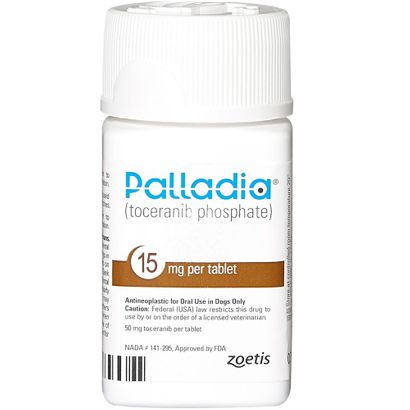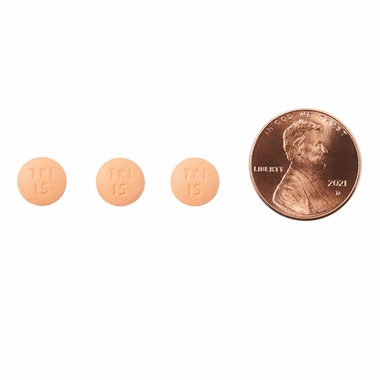Sitewide Sale! 15% OFF Use Code EPX15 *
Palladia for Dogs - (toceranib phosphate) 15 mg (30 Tablets) - [Prevents Tissue Inflammation]
- Notice
- Description
- Ingredients
- Directions
- FAQ
- Reviews
Notices
Limit 1 Palladia products per customer.
Description
Palladia (15 mg) is an antiproliferative and antiandiogenic agent used to treat Patnaik grade II or III, cutaneous mast cell tumors in dogs.
This medication uses toceranic phosphate to combat the effects of these recurrent tumors and works on both tumors with and without regional lymph node involvement. Palladia can also be used as an alternative to chemotherapy for other various types of tumors, including melanomas, thyroid carcinomas, and more.Palladia is available in 10 mg, 15 mg, and 50 mg tabs to ensure that adjusting your dog’s dosage based on their weight is a simple manner. Each dosage is available for purchase by the tab or in a container of 30 tabs.
Key Features
- Treats Patnaik grade II or III recurrent, cutaneous mast cell tumors in dogs
- Can be used as alternative to chemotherapy for other types of tumors
- Available in three different dosages in singles doses or packs of 30
Product Uses
Conditions Treated
- Squamous cell carcinoma
- Metastatic osteosarcoma
- Malignant Melanoma
- Anal sac adrenocarcinoma
- Vaccine Associated Fibrosarcoma
- Transitional Cell Carcinoma
- Thyroid Carcinoma
Dosing
Administration
Ingredients
Active Ingredient
Toceranib
Directions
Dosage & Administration
Always provide the Client Information Sheet with the prescription. The recommended starting dose of Palladia is 3.25 mg/kg (1.48 mg/lb) of body weight, administered orally every other day.
If adverse reactions occur, your veterinarian may reduce the dose by 0.5 mg/kg, to a minimum of 2.2 mg/kg (1.0 mg/lb), or pause treatment for up to two weeks. Dose adjustments should be based on veterinary assessments, typically conducted weekly for the first six weeks, and approximately every six weeks thereafter.
Palladia may be given with or without food. Do not split or crush tablets.
Quick Tips
- Consult your veterinarian to determine the correct starting dose for your dog.
- Dose is based on body weight and may require adjustment over time.
- Administer Palladia every other day, as directed.
- Tablet reductions or dose interruptions may be used to manage side effects.
- Veterinary follow-ups are essential to monitor your pet’s response and safety.
Dosage Table
The dosage chart below outlines tablet combinations based on your dog’s weight. Your veterinarian will select the appropriate strength(s) to reach the target dose.
Note: Full dosage table available on product label. The below is for general guidance only.
| Pounds | Kilograms | Dose | 10 mg | 15 mg | 50 mg |
|---|---|---|---|---|---|
| 11.0 - 11.8 | 5.0 - 5.3 | 15 mg | 1 | ||
| 11.9 - 15.2 | 5.4 - 6.9 | 20 mg | 2 | ||
| 15.3 - 18.5 | 7.0 - 8.4 | 25 mg | 1 | 1 | |
| 18.6 - 22.0 | 8.5 - 10.0 | 30 mg | 2 | ||
| 22.1 - 25.4 | 10.1 - 11.5 | 35 mg | 2 | 1 | |
| 25.5 - 28.7 | 11.6 - 13.0 | 40 mg | 1 | 2 | |
| 28.8 - 32.2 | 13.1 - 14.6 | 45 mg | 3 | ||
| 32.3 - 35.5 | 14.7 - 16.1 | 50 mg | 1 |
Storage Directions
Store Palladia at controlled room temperature between 20°C to 25°C (68°F to 77°F). Keep out of reach of children and pets.
Contraindications
Do not use in dogs that are pregnant, lactating, or intended for breeding.
Warnings
Palladia may cause vascular dysfunction, which can lead to edema and thromboembolism, including pulmonary thromboembolism. If these signs occur, discontinue use until clinical symptoms and laboratory values return to normal. To maintain vascular stability, wait at least three days after stopping treatment before performing surgery.
Human Warnings
NOT FOR HUMAN USE. KEEP OUT OF REACH OF CHILDREN.
Children should avoid contact with treated dogs, especially their feces, urine, or vomit. Adults should wear gloves and wash hands after handling the medication or waste. Avoid direct contact with broken or moistened tablets. Dispose of gloves and waste in sealed plastic bags.
If accidental eye exposure occurs, rinse thoroughly with water. In case of accidental ingestion, contact a physician immediately. Pregnant women, or those who may become pregnant, should take special care when handling Palladia, as it may interfere with blood vessel formation in the developing fetus and cause birth defects.
Potential Side Effects
In a U.S. clinical study of 151 dogs, the most commonly reported side effects included:
- Diarrhea
- Vomiting
- Anorexia (loss of appetite)
- Lethargy
- Lameness
- Weight loss
- Bloody stool
- Dehydration
- Itching (pruritus)
- Pigmentation changes
- Dermatitis
- Musculoskeletal disorders
FAQ
Reviews
- Price
- Pharmacy will call your vet and obtain a faxed Rx for quick filling of your pets meds.













